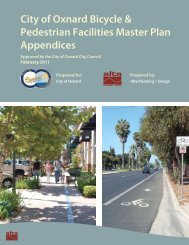View File - Development Services - City of Oxnard
View File - Development Services - City of Oxnard
View File - Development Services - City of Oxnard
Create successful ePaper yourself
Turn your PDF publications into a flip-book with our unique Google optimized e-Paper software.
WATER RESOURCES TECHNICAL REPORT7.2 Phase 2 Scenarios7.2.1 Groundwater Recharge Using Recycled WaterIn addition to creating a new source <strong>of</strong> potable water supply for the <strong>City</strong> that will meet thefuture demand <strong>of</strong> the <strong>City</strong>, implementing the GREAT Program elements <strong>of</strong> the Phase 2scenarios will have the following benefits:• Scenarios 2a and 2b will result in large increases in groundwater elevations over broadareas across the southern <strong>Oxnard</strong> Plain and Pleasant Valley areas as a result <strong>of</strong>delivering recycled water to growers (Ocean <strong>View</strong> pipeline, PTP system, and PVCWDsystem) in lieu <strong>of</strong> those growers pumping groundwater (19,286 AFY). Based on themodel simulations, water levels increased up to 30 feet in the UAS and up to 60 feet inthe LAS. These water level increases will significantly help to further minimize thealready low potential that exists for coastal landward flow (seawater intrusion) in theUAS and significantly help to decrease the severe overdraft conditions and water qualitydegradation that exist in the LAS <strong>of</strong> the southern <strong>Oxnard</strong> Plain and Pleasant Valleyareas.• Scenarios 2c and 2c2 will result in very large increases in groundwater elevations alongthe coastal injection wells (seawater intrusion barrier) as a result <strong>of</strong> injecting recycledwater in this area (6,172 AFY). Based on the model simulations, water levels increasedup to 80 feet in the LAS along the injection wells and up to 30 feet in the UAS across thesouthern <strong>Oxnard</strong> Plain and Pleasant Valley areas with this additional measure. Theseadditional water level increases will significantly help to decrease the severe overdraftconditions and water quality degradation that exist in the LAS <strong>of</strong> the southern <strong>Oxnard</strong>Plain. Water levels will approach 80 feet above sea level along the injection wells duringthe winter injection period. Annually, these water levels will cycle from this high pointduring injection to approximately near sea level during the remaining noninjectionperiod. The year-round average gradient will be significantly above sea level and will besufficient to create seaward flow and reverse the seawater intrusion along southern<strong>Oxnard</strong> Plain coastal area.7.2.2 Groundwater Recovery for Potable UseAs noted above, the quantities <strong>of</strong> water recharged and recovered are much higher forPhase 2 compared to Phase 1. Recovery <strong>of</strong> these higher quantities <strong>of</strong> water for potable use inPhase 2 will result in significantly greater decreases in groundwater elevations than forPhase 1. It will be important to adhere to best management practices to minimizedrawdown for Phase 2 elements <strong>of</strong> the GREAT Program because <strong>of</strong> these greater water leveldeclines and the potential for adverse impacts. Potential adverse impacts could include thefollowing:• In the UAS, water level declines could increase the potential to induce brief periods <strong>of</strong>coastal landward flow during extended, drier climatic periods.• In the LAS, water level declines could increase the moderate potential for landward flowthat exists, particularly during drier years and in the fall when water levels areseasonally low.W112003002SCO LW1458.DOC/ 033390002 98
















